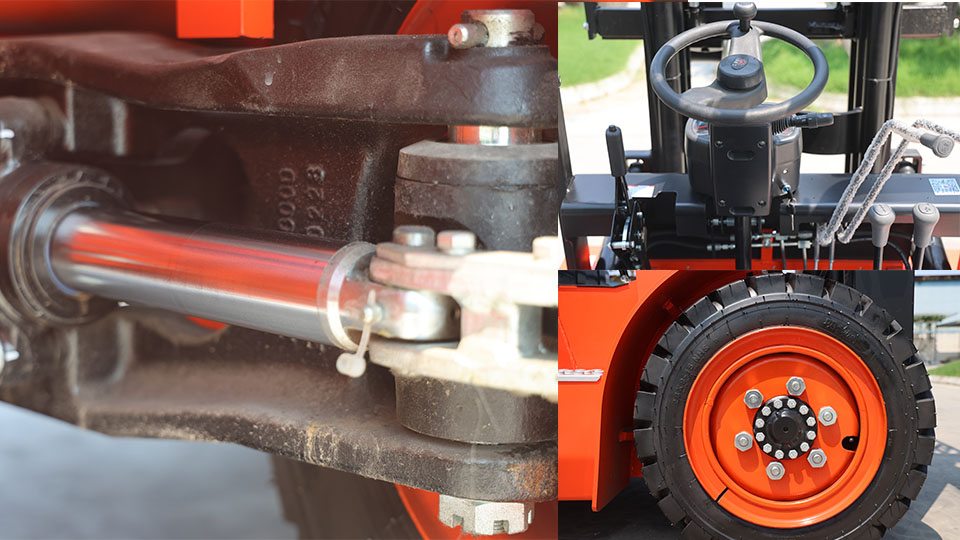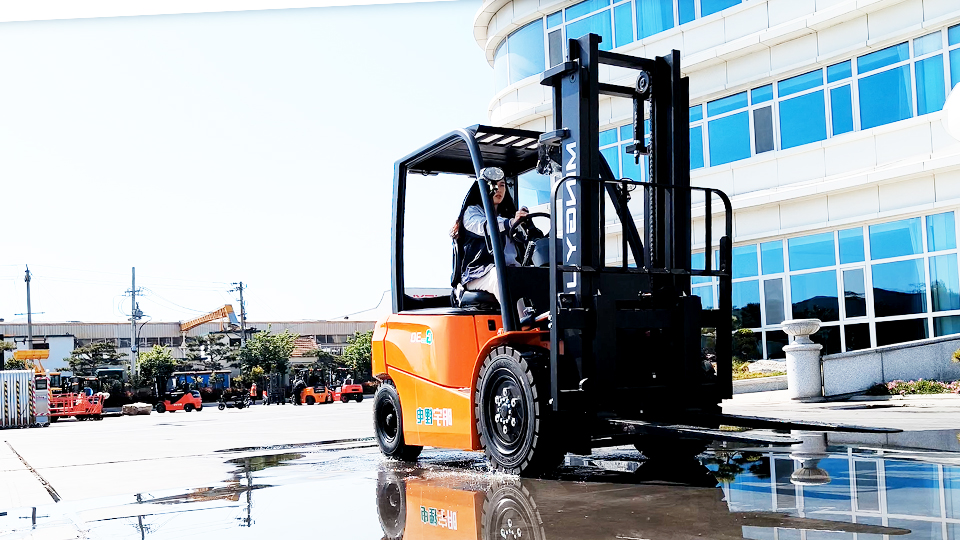
The Dynamic Danger: A Technical Analysis of the Forklift Operation Fall Zone
The term "fall zone" is often narrowly interpreted as the area directly beneath a suspended load.2 However, in the context of powered industrial truck (PIT) operations, particularly those involving high-lift, high-reach, or load-tilting movements, the fall zone is a dynamic, multi-dimensional hazard area. This article provides a comprehensive, technical examination of the forklift fall zone, drawing upon regulatory standards, engineering principles, and best-practice risk assessment methodologies.
I. The Regulatory Foundation: Defining the Exclusion Perimeter
The primary purpose of defining a fall zone is to establish a non-entry exclusion zone for non-essential personnel, thereby preventing struck-by injuries which are a leading cause of fatalities in material handling environments.3
A. OSHA's General Definition
The Occupational Safety and Health Administration (OSHA) regulations provide a foundational, though not perfectly prescriptive, definition of this hazard. While the specific standard for powered industrial trucks (29 CFR 1910.178) focuses heavily on operator training and vehicle condition, the concept of a fall zone is implicitly and explicitly referenced across material handling standards, notably:
Explicit Prohibition: OSHA explicitly prohibits employees from standing or passing directly under a raised portion of the truck or its load (an obvious, static fall zone).4
Dynamic Load Handling (Cranes/Construction): The concept is more rigidly defined in the construction standards (29 CFR 1926.1425), where the "fall zone" is defined as the area "in which it is reasonably foreseeable that partially or completely suspended materials could fall in the event of an accident." This regulation further mandates that while a load is suspended, no employee shall be in the fall zone, save for those engaged in essential tasks like hooking, unhooking, or guiding the load.5 This principle is applied by extension to all high-lift PIT operations.

B. The Minimum Safe Distance Heuristic
Since a single, universal metric is impractical given the diversity of loads and equipment, industry best practices have converged on a series of heuristics for establishing a minimum safe distance. The most widely adopted is the "Twice the Height" rule or the minimum 10-foot (3-meter) radius from the load's projection on the floor.6
The 10-Foot (3-Meter) Radius: This is often cited as the absolute minimum exclusion perimeter around a raised load.7 It provides a buffer that attempts to account for simple load sloughing, minor mast drift, or initial load shift before a complete collapse.
The 2:1 Ratio (Twice the Height): A more robust heuristic is to establish the fall zone radius as at least twice the vertical height of the lifted material.8 For a load lifted 15 feet high, the fall zone would be a circle with a 30-foot radius centered directly under the load. This is a conservative, risk-averse model accounting for load trajectory and kinetic energy dissipation upon failure.
II. The Physics and Kinematics of Load Failure
The actual geometry of the fall zone must be determined not just by linear distance, but by the physical failure modes of the load, the equipment, and the environment.9
A. Load Stability and Center of Gravity (CG)
The stability of a load on the forks is governed by the principles of the Stability Triangle (the base formed by the front axle and the pivot point of the steering axle) and the horizontal distance of the load's CG from the mast face, known as the Load Center.
Lateral Load Shift: If a load's CG shifts laterally (due to an unstable stack, uneven weight, or rapid turning), the exclusion zone must account for the angular momentum of the load. A toppling load does not fall vertically; it arcs outwards. The maximum kinetic energy vector, $\vec{K}_{max}$, will follow a parabolic path, $\vec{P}(t)$, determined by the load's initial angular velocity, $\omega_0$, and the coefficient of friction with the fork face, $\mu$.
$$\text{Fall Zone Radius} \approx \text{Load Height} \times \tan(\theta_{tilt}) + \text{Load Width}$$
Where $\theta_{tilt}$ is the maximum angle of tilt before the load's vertical CG projection moves outside the supporting base (the forks or the Stability Triangle).
Vertical Load Failure (Sloughing): For non-homogenous loads (e.g., a pallet of bagged material), the failure mode is often sloughing rather than catastrophic collapse. In this scenario, individual units detach and follow a simple free-fall trajectory.
$$\text{Horizontal Projection} = \frac{v_{h} \cdot \sqrt{2h}}{g}$$
Where $v_h$ is the initial horizontal velocity (from the truck's speed), $h$ is the height of the unit, and $g$ is the acceleration due to gravity. The fall zone must accommodate this horizontal projection, especially at lift heights over 15 feet.
B. Equipment Dynamics and Tip-Over
The fall zone is also dictated by the potential for a lateral or longitudinal tip-over of the forklift itself. This introduces a "sphere of influence" beyond the load itself, as the mass of the truck, counterweight, and mast assembly creates an immense hazard.
Lateral Tip-Over: Caused by turning too quickly with a raised load. The exclusion zone must encompass the entire footprint of the forklift plus the load. The impact zone for the counterweight alone is massive.
Longitudinal Tip-Over: Caused by carrying an overloaded or improperly centered load. The forks and mast will violently crash to the ground, and the exclusion zone must account for the whip effect, where structural components may fracture and be propelled outward.
III. Mitigating the Dynamic Fall Zone: Engineering and Administrative Controls
Since the fall zone is dynamic, its management requires a layered approach using engineering controls (physical barriers), administrative controls (procedures/training), and a critical element of situational awareness.10
A. Engineering Controls
These physical measures are the most effective means of separating the hazard from personnel.
Hard Barriers: The use of structural steel guardrails or bollards to physically separate designated pedestrian walkways from forklift thoroughfares.11 This creates a permanent, non-negotiable fall zone boundary for travel paths.
Visual Indicators (Floor Marking): High-visibility floor paint or tape is used to clearly mark forklift-only zones and pedestrian-only zones.12
Proximity/Collision Avoidance Systems: Modern telematics and safety systems utilize Ultra-Wideband (UWB) tags worn by pedestrians and sensors on the forklifts.13 These systems create a virtual, programmable fall zone (exclusion zone), sounding audible and visual alarms on both the truck and the pedestrian tag if the programmed minimum safe distance (e.g., 10 feet) is violated.14 This is the closest technical approximation to a real-time, dynamic fall zone controller.
Forklift Spotlights (Blue/Red Lights): Projecting a visible light spot (often blue or red) 10 to 15 feet in front of and behind the moving forklift provides a visual, moving perimeter representing the truck’s stopping distance and immediate danger area.15

B. Administrative Controls and Procedures
These procedures govern personnel behavior within the facility to respect the dynamically changing fall zone.
|
Control Measure |
Technical Rationale |
|
No Go/Walk-Under Policy |
Absolute enforcement against standing or passing under any raised load, irrespective of duration. Mitigates $h \rightarrow 0$ risk. |
|
Eye Contact and Confirmation |
Pedestrians must confirm eye contact with the operator and receive a definitive hand signal (or verbal/radio confirmation) before proceeding near the work zone. Mitigates human factors (inattention). |
|
Use of a Dedicated Spotter |
Required when a lift operation involves an obscured view, high lift (over 15 feet), or moving through a congested area. The spotter's sole function is to enforce the perimeter of the fall zone. |
|
Speed Control |
Limiting forklift travel speed to a maximum of 3–5 mph in high-traffic or high-lift zones. This dramatically reduces the kinetic energy ($\frac{1}{2}mv^2$) of the truck and the horizontal projection of a falling load. |
IV. Conclusion: Risk Assessment and Continuous Improvement
The "fall zone" for a forklift operation is not a fixed, single dimension but a probabilistic boundary defined by a comprehensive risk assessment. While a 10-foot (3-meter) radius serves as a baseline for low-lift, stable loads, the true fall zone radius must be expanded based on the 16$\text{Height}$, 17$\text{Weight}$, 18$\text{Speed}$, and 19$\text{Stability}$ (HWS2) of the operation.20
Safety compliance demands that employers select and implement controls (from physical barriers to advanced proximity systems) that enforce a dynamic exclusion zone that is always greater than or equal to the potential arc of failure. The ultimate goal is to apply the Hierarchy of Controls—starting with Elimination (designing processes to avoid lifting over people) and Engineering (creating physical separation)—to effectively render the theoretical fall zone irrelevant to non-essential personnel.
Name: selena
Mobile:+86-13176910558
Tel:+86-0535-2090977
Whatsapp:8613181602336
Email:vip@mingyuforklift.com
Add:Xiaqiu Town, Laizhou, Yantai City, Shandong Province, China